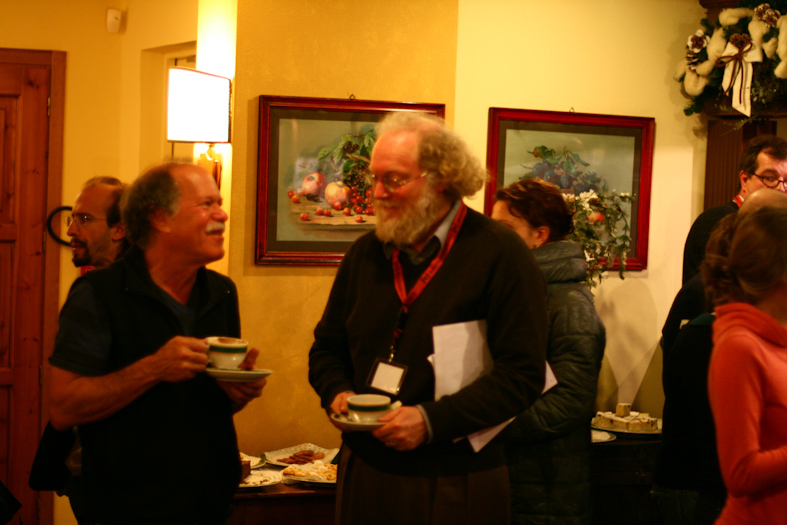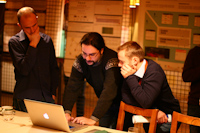outreach
EE² - Epiwork/Epifor 2nd International Workshop - day 3 Jan. 21, 2012
The third day saw the conclusion of the conference with a wonderful snowfall! The last sessions of the meeting featured very interesting talks on the modeling of seasonal flu, dengue, disease spreading within hospitals and other important topics concerning modeling of infectious diseases.

The first session was devoted to the role of population structure and to the model design. Elizabeth Halloran from the University of Washington focused on population structure at the small scale. She introduced the minicommunity design, a method to account for the structure of households, and other small transmission units, in the modeling study of vaccination. Stephen Eubank from the Virginia Bioinformatics Institute discussed the value and limitation of networks models for disease spreading. In the last talk of the session Ira Longini of the University of Washington presented a thorough study of Dengue. In collaboration with his team he designed a geographically explicitly model based on collected epidemiological data in order to study the impact of possible vaccination strategies and the role of seasonality factors.

The speakers of the second morning session tackled very relevant topics, such as the spreading of diseases within hospitals and the role of demography on the disease transmission. Fredrick Liljeros from the Department of Sociology of the Stockholm University presented the analysis of a dataset of patient flows among wards highlighting important features of this system and pointing out the importance of these data for understanding disease spread within hospitals. Piero Manfredi of the University of Pisa discussed about the current demographic transformations in Europe and their impact on the dynamics of infection and on the vaccination control.

The last session featured two interesting talks focusing on the understanding and modeling of seasonal influenza. Gabriela Gomes of the Institute Gulbenkian de Ciência presented an accurate modeling study of the correlation between transmissibility of influenza and weather conditions such as temperature and humidity. The model is based on data of temperature and humidity as well as on epidemiological data collected from surveillance and within the project influenzanet (have a look at influweb and grippenet, the websites of the project in Italy and France respectively). Eventually, the last talk of the conference was given by Lewi Stone from the Tel Aviv University, who presented a modeling study of the observed dynamics of the seasonal influenza in Israel.
 After lunch the conference concluded with the two parallel round tables. Nikolaos Stilianakis of the Joint Research Center chaired the very interesting discussion on the interaction between modelers and epidemiologists on one side and public health agencies on the other, which focused mainly on the case of the recent H1N1 pandemic. The discussion pointed out the efforts that in that occasion allowed the fruitful collaboration among epidemiologists and public health agencies. However an increase in communication and data sharing was felt to be strongly needed in order to make possible a prompt and effective response to pandemic emergencies. Denis Chao of the Center for Statistics and Quantitative Infectious Diseases of Seattle led the round table on models, data needs, and forecast, which focused on the importance and necessity of data for the design of predictive models. The recent developments on data collection allowed by new technologies are promising. Nevertheless a great attention has to be devoted to the analysis of such data in order to avoid misleading information and wrong conclusions. Again a strong pressure is felt for the critical issue of data sharing.
After lunch the conference concluded with the two parallel round tables. Nikolaos Stilianakis of the Joint Research Center chaired the very interesting discussion on the interaction between modelers and epidemiologists on one side and public health agencies on the other, which focused mainly on the case of the recent H1N1 pandemic. The discussion pointed out the efforts that in that occasion allowed the fruitful collaboration among epidemiologists and public health agencies. However an increase in communication and data sharing was felt to be strongly needed in order to make possible a prompt and effective response to pandemic emergencies. Denis Chao of the Center for Statistics and Quantitative Infectious Diseases of Seattle led the round table on models, data needs, and forecast, which focused on the importance and necessity of data for the design of predictive models. The recent developments on data collection allowed by new technologies are promising. Nevertheless a great attention has to be devoted to the analysis of such data in order to avoid misleading information and wrong conclusions. Again a strong pressure is felt for the critical issue of data sharing.
 The last day of the workshop saw also the conclusion of the poster session that lasted for all the three days and took place during the coffee breaks. It was a nice occasion to interact with researchers and have informal and stimulating discussions on several topics including surveillance methods, software development, and mathematical models. The Epifor team presented five posters dedicated to the research projects currently carried out within the project. Andrea Apolloni presented a theoretical work done in collaboration with the EpiFor team on the impact of heterogeneities in the travel frequency and contact pattern of individuals on the geographical spread of infectious diseases. Paolo Bajardi presented a work on the epidemiological implications of the structure and dynamics of the cattle trade network with his poster titled Seeds clustering and sentinel identification for disease spreading on dynamical networks. Chiara Poletto presented a poster titled Heterogeneous length of stay of hosts’ movements and spatial epidemics spread on a theoretical and computational analysis of the impact on the epidemic invasion of the observed heterogeneities in the hosts’ trip durations. Michele Tizzoni’s poster focused on the study of the impact of travel restrictions in delaying and containing the spreading of an epidemic. The study combines a theoretical analysis with a computational modeling work and, by considering the recent H1N1 pandemic as paradigmatic example, shows the scarce effectiveness of such an intervention measure. Finally Corrado Gioannini presented a poster titled Integrating the GLEaMviz Simulator tool with the Epidemic Marketplace platform, regarding the integration of the GLEaMviz simulator with the Epidemic Marketplace information platform carried out within the EpiWork project. The occasion allowed Corrado to also offer a hands-on exhibition of the GLEaMviz Simulator by showing the tool and its most recent developments and added capabilities.
The last day of the workshop saw also the conclusion of the poster session that lasted for all the three days and took place during the coffee breaks. It was a nice occasion to interact with researchers and have informal and stimulating discussions on several topics including surveillance methods, software development, and mathematical models. The Epifor team presented five posters dedicated to the research projects currently carried out within the project. Andrea Apolloni presented a theoretical work done in collaboration with the EpiFor team on the impact of heterogeneities in the travel frequency and contact pattern of individuals on the geographical spread of infectious diseases. Paolo Bajardi presented a work on the epidemiological implications of the structure and dynamics of the cattle trade network with his poster titled Seeds clustering and sentinel identification for disease spreading on dynamical networks. Chiara Poletto presented a poster titled Heterogeneous length of stay of hosts’ movements and spatial epidemics spread on a theoretical and computational analysis of the impact on the epidemic invasion of the observed heterogeneities in the hosts’ trip durations. Michele Tizzoni’s poster focused on the study of the impact of travel restrictions in delaying and containing the spreading of an epidemic. The study combines a theoretical analysis with a computational modeling work and, by considering the recent H1N1 pandemic as paradigmatic example, shows the scarce effectiveness of such an intervention measure. Finally Corrado Gioannini presented a poster titled Integrating the GLEaMviz Simulator tool with the Epidemic Marketplace platform, regarding the integration of the GLEaMviz simulator with the Epidemic Marketplace information platform carried out within the EpiWork project. The occasion allowed Corrado to also offer a hands-on exhibition of the GLEaMviz Simulator by showing the tool and its most recent developments and added capabilities.

Posts by category: awards/honors, news, outreach, publications, research, talks, team news



